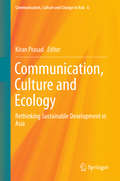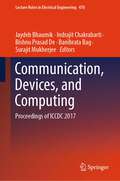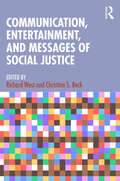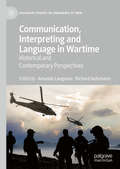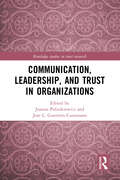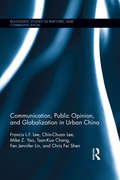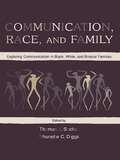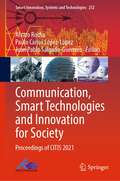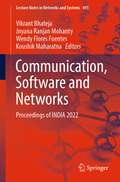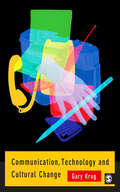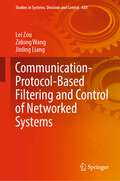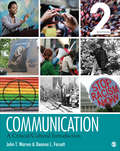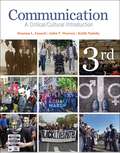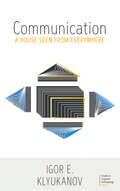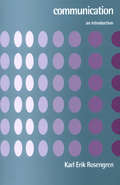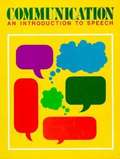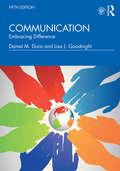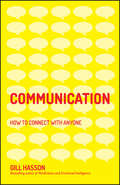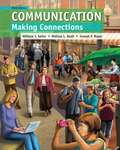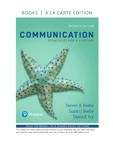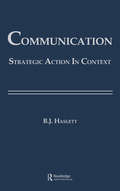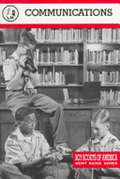- Table View
- List View
Communication, Culture and Confrontation (Communication Processes)
by Bernard Bel, Jan Brouwer, Biswajit Das, Vibodh Parthasarathi, Guy PoitevinThe third and final volume in the series on Communication Processes, Communication, Culture and Confrontation is a bold attempt at breaking conceptual and methodological impasses which stifle communication studies. Departing from established frameworks and dated technological metaphors such as ′transmission′, the present volume explores and analyzes different forms of communication media in relation to the cultural configurations and contending forces that permeate them. Positioned at the interface of culture and communication studies, the discourse in the book engages with multiple voices, bringing together academic scholars and grassroot social animators. Exploring seven different popular cultural forms, such as rituals, songs, narratives, calendar art, pamphlets, and so on, through 18 case studies, it goes on to suggest a complex model of communication. In this framework, cultures cannot be viewed as items exchanged in the hegemonic space of global communication. Cultural configurations display themselves as ′evolutive′ forms of social communication that weave human beings into collectives and bind these collectives with one another—all permeated with the power parameter. Cultures ′perform′ viable collectives when they come to be apprehended in a field of contending forces: a milieu of exchange, encounter, confrontation and possibly conflict. This volume will be invaluable for students of communication, culture studies, sociology and journalism.
Communication, Culture and Ecology: Rethinking Sustainable Development in Asia (Communication, Culture and Change in Asia #6)
by Kiran PrasadThis book offers comprehensive insights into the cultural and ecological values that influence sustainable development across Asia, addressing the cultural, religious and philosophical moorings of development through participatory and grassroots communication approaches. It presents a range of contributions and case studies from leading experts in Asia to highlight the debates on environmental communication and sustainable development that are relevant today, and to provide an overview of the positive traditions of ecological sensitivity and cultural communication that may find common ground between communities. This well-researched guide to the dynamic and complex terrain of communication for sustainable development offers uniquely practical perspectives on communication, environment and sustainable development that are of immense value for policy makers, media scholars, development practitioners, researchers and students of communication and media studies.
Communication, Devices, and Computing: Proceedings of ICCDC 2017 (Lecture Notes in Electrical Engineering #470)
by Indrajit Chakrabarti Jaydeb Bhaumik Bishnu Prasad De Banibrata Bag Surajit MukherjeeThis book provides insights into the First International Conference on Communication, Devices and Computing (ICCDC 2017), which was held in Haldia, India on November 2–3, 2017. It covers new ideas, applications and the experiences of research engineers, scientists, industrialists, scholars and students from around the globe. The proceedings highlight cutting-edge research on communication, electronic devices and computing, and address diverse areas such as 5G communication, spread spectrum systems, wireless sensor networks, signal processing for secure communication, error control coding, printed antennas, analysis of wireless networks, antenna array systems, analog and digital signal processing for communication systems, frequency selective surfaces, radar communication, and substrate integrated waveguide and microwave passive components, which are key to state-of-the-art innovations in communication technologies.
Communication, Entertainment, and Messages of Social Justice
by Richard West Christina S. BeckThis edited collection explores the contemporary interplay among three pivotal areas found in cultures around the world: communication, entertainment, and messages of social justice. Each chapter centralizes communication as instrumental in creating mediated messages pertaining to social justice, usually resulting in a more educated audience.Using an accessible writing style, the contributors investigate both classic and contemporary social media, television, film, stage, radio, and podcast productions by employing both qualitative and quantitative methods. Furthermore, through case studies on topics including transphobia, indigenous comedy and drag performance, this book assesses key issues and themes portrayed in contemporary entertainment education. It provides a foundational framework for analysis by utilizing a broad range of theoretical models to explore representations of race, class, gender, advocacy, and pedagogy among others as well as their communication implications.This book will be of interest to scholars and students in the fields of Communication Studies, Popular Culture Studies, Media Studies, Theatre Studies, Social Justice Studies, Sociology, and Psychology.
Communication, Interpreting and Language in Wartime: Historical and Contemporary Perspectives (Palgrave Studies in Languages at War)
by Richard Gehrmann Amanda LaugesenThis edited book provides a multi-disciplinary approach to the topics of translation and cross-cultural communication in times of war and conflict. It examines the historical and contemporary experiences of interpreters in war and in war crimes trials, as well as considering policy issues in communication difficulties in war-related contexts. The range of perspectives incorporated in this volume will appeal to scholars, practitioners and policy-makers, particularly in the fields of translating and interpreting, conflict and war studies, and military history.
Communication, Leadership and Trust in Organizations (Routledge Studies in Trust Research)
by Joanna Paliszkiewicz Cusumano, Jose L. GuerreroTrust in communication and leadership is the key to success in business. This book presents and discusses the main issues and challenges posed by communication, leadership, and trust. The first part of the book describes the communication and trust issues, the second part presents the role of trust in leadership, and the third part describes different examples of implementing trust to organizations. Readers will gain from this book theoretical and practical knowledge of communication, leadership, and trust; empirically validated practice regarding trust and its related concepts; and a novel approach for addressing this topic. This book can be used as a toolbox to improve understanding and opportunities related to building trust in organizations and will be especially valuable for students and researchers in the fields of leadership, organizational communication, business ethics, and trust research.
Communication, Public Discourse, and Road Safety Campaigns: Persuading People to Be Safer (Routledge Studies in Rhetoric and Communication)
by Nurit GuttmanThis book discusses the use of communication campaigns to promote road safety, arguing that they need to elicit public discourse on issues pertaining to culture, equity, gender, workplace norms, environmental issues, and social solidarity. Increasingly, new media channels and formats are employed in the dissemination process, making road safety-related messages ubiquitous, and often controversial. Policy makers, educators, researchers, and the public continue to debate the utility and morality of some of the influence tactics employed in these messages, such as the use of graphic images of injury or death, stigmatization (or "blame and shame"), and the use of "black humor." Guttman argues that influencing road safety requires making changes in normative and cultural conceptions of broader issues in society, yet the typical discourse on road safety tends to focus on individual attitudes and practices. The book highlights the importance of social and behavioral theory in communication campaigns on road safety, and critiques the tendency to focus on individual cognition, affect, and risk conceptions rather than on normative, structural, and cultural factors. The volume positions the discourse on road safety as a social issue, and treats road safety behavior as a social activity that directly relates to other public issues, social values, and social policy, while discussing potential uses of social media and participatory approaches. The discussion turns to the role of road safety communication campaigns as part of a democratic process of eliciting public discourse, including how contemporary society could address broader issues of risk and safety.
Communication, Public Opinion, and Globalization in Urban China (Routledge Studies in Rhetoric and Communication)
by Chin-Chuan Lee Francis L.F. Lee Mike Z. Yao Tsan-Kuo Chang Fen Jennifer Lin Chris Fei ShenAs China is increasingly integrated into the processes of economic, political, social, and cultural globalization, important questions arise about how Chinese people perceive and evaluate such processes. At the same time, international communication scholars have long been interested in how local, national, and transnational media communications shape people’s attitudes and values. Combining these two concerns, this book examines a range of questions pertinent to public opinion toward globalization in urban China: To what degree are the urban residents in China exposed to the influences from the outside world? How many transnational social connections does a typical urban Chinese citizen have? How often do they consume foreign media? To what extent are they aware of the notion of globalization, and what do they think about it? Do they believe that globalization is beneficial to China, to the city where they live, and to them personally? How do people’s social connections and communication activities shape their views toward globalization and the outside world? This book tackles these and other questions systematically by analyzing a four-city comparative survey of urban Chinese residents, demonstrating the complexities of public opinion in China. Media consumption does relate, though by no means straightforwardly, to people’s attitudes and beliefs, and this book provides much needed information and insights about Chinese public opinion on globalization. It also develops fresh conceptual and empirical insights on issues such as public opinion toward US-China relations, Chinese people’s nationalistic sentiments, and approaches to analyze attitudes toward globalization.
Communication, Race, and Family: Exploring Communication in Black, White, and Biracial Families (Routledge Communication Series)
by Thomas J. Socha Rhunette C. DiggsThis groundbreaking volume explores how family communication influences the perennial and controversial topic of race. In assembling this collection, editors Thomas J. Socha and Rhunette C. Diggs argue that the hope for managing America's troubles with "race" lies not only with communicating about race at public meetings, in school, and in the media, but also--and more fundamentally--with families communicating constructively about race at home. African-American and European-American family communication researchers come together in this volume to investigate such topics as how Black families communicate to manage the issue of racism; how Black parent-child communication is used to manage the derogation of Black children; the role of television in family communication about race; the similarities and differences between and among communication in Black, White, and biracial couples and families; and how family communication education can contribute to a brighter future for all. With the aim of developing a clearer understanding of the role that family communication plays in society's move toward a multicultural world, this volume provides a crucial examination of how families struggle with issues of ethnic cultural diversity.
Communication, Smart Technologies and Innovation for Society: Proceedings of CITIS 2021 (Smart Innovation, Systems and Technologies #252)
by Álvaro Rocha Paulo Carlos López-López Juan Pablo Salgado-GuerreroThis book gathers high-quality papers presented at International Conference on Science, Technology and Innovation for Society (CITIS 2021), held in Guayaquil, Ecuador, on May 26–28, 2021. This book will present the recent research trends in the fields of software engineering, big data analysis, cloud computing, data engineering, data management and data mining, machine learning, deep learning, artificial intelligence, smart systems, robotics and automation, mechatronic design, and industrial processes design.
Communication, Software and Networks: Proceedings of INDIA 2022 (Lecture Notes in Networks and Systems #493)
by Koushik Maharatna Vikrant Bhateja Jnyana Ranjan Mohanty Wendy Flores FuentesThis book highlights a collection of high-quality peer-reviewed research papers presented at the 7th International Conference on Information System Design and Intelligent Applications (INDIA 2022), held at BVRIT Hyderabad College of Engineering for Women, Hyderabad, Telangana, India, from February 25–26, 2022. It covers a wide range of topics in computer science and information technology, from wireless networks, social networks, wireless sensor networks, information and network security, to web security, Internet of Things, bioinformatics, geoinformatics, and computer networks.
Communication, Technology and Cultural Change
by Gary J KrugWith a foreword by Norman Denzin Communication and the history of technology have invariably been examined in terms of artefacts and people. Gary Krug argues that communication technology must be studied as an integral part of culture and lived-experience. Rather than stand in awe of the apparent explosion of new technologies, this book links key moments and developments in communication technology with the social conditions of their time. It traces the evolution of technology, culture, and the self as mutually dependent and influential. This innovative approach will be welcomed by undergraduates and postgraduates needing to develop their understanding of the cultural effects of communication technology, and the history of key communication systems and techniques.
Communication-Protocol-Based Filtering and Control of Networked Systems (Studies in Systems, Decision and Control #430)
by Zidong Wang Lei Zou Jinling LiangCommunication-Protocol-Based Filtering and Control of Networked Systems is a self-contained treatment of the state of the art in communication-protocol-based filtering and control; recent advances in networked systems; and the potential for application in sensor networks. This book provides new concepts, new models and new methodologies with practical significance in control engineering and signal processing. The book first establishes signal-transmission models subject to different communication protocols and then develops new filter design techniques based on those models and preset requirements for filtering performance. The authors then extend this work to finite-horizon H-infinity control, ultimately bounded control and finite-horizon consensus control. The focus throughout is on three typical communications protocols: the round-robin, random-access and try-once-and-discard protocols, and the systems studied are drawn from a variety of classes, among them nonlinear systems, time-delayed and time-varying systems, multi-agent systems and complex networks. Readers are shown the latest techniques—recursive linear matrix inequalities, backward recursive difference equations, stochastic analysis and mapping methods. The unified framework for communication-protocol-based filtering and control for different networked systems established in the book will be of interest to academic researchers and practicing engineers working with communications and other signal-processing systems. Senior undergraduate and graduate students looking to increase their knowledge of current methods in control and signal processing of networked systems will also find this book valuable.
Communication: A Critical/Cultural Introduction
by Dr Deanna L. Fassett Dr John T. WarrenCommunication: A Critical/Cultural Introduction, Second Edition introduces communication, from intimate and interpersonal to the public and mediated, as cultural. Using contemporary critical theory, authors John T. Warren and Deanna L. Fassett focus on communication as advocacy—inherently influenced by culture, history and power. By situating communication concepts and theories within contemporary and engaging cultural scenes, the book is much more than a survey of ideas—it demonstrates the power of communication in our everyday lives.
Communication: A Critical/cultural Introduction
by Keith Nainby Deanna L. Fassett John T. WarrenThe third edition of Communication: A Critical/Cultural Introduction provides a comprehensive, yet focused, overview of communication theory, interpersonal communication, and public communication and culture through the lens of contemporary critical theory. The text shows how we produce our world through communication, challenging us to explore power, ideology, and diversity through daily interactions, both public and private. <P><P> The book begins with explanations of how communication relates to culture and power, how to distinguish between representative and constitutive communication, and how to build a message for an audience with an emphasis on social advocacy. Later chapters explore the responsibilities of speakers and listeners, alliance-building, the application of communication theory in the study of identity and perception, the relationship between language and culture, nonverbal communication, and more. The text closes with a discussion of communication as a means of social action, encouraging readers to use communication as a foundation for the advancement of issues that matter most to them.
Communication: A House Seen from Everywhere (Studies in Linguistic Anthropology #2)
by Igor E. KlyukanovFocusing on the scientific study of communication, this book is a systematic examination. To that end, the natural, social, cultural, and rational scientific perspectives on communication are presented and then brought together in one unifying framework of the semiotic square, showing how all four views are interconnected. The question of whether the study of communication can be considered a unique science is addressed. It is argued that communication is never separate from any object of study and thus we always deal with its manifestations, captured in the four scientific perspectives discussed in the book.
Communication: An Introduction (Sage Series In Communication Research Ser. #19)
by Karl Erik RosengrenWritten as an introduction for beginning students, this book offers a thorough, yet lively, overview of human communication in all its aspects. Accessibly written and assuming no prior knowledge of the discipline Communication: An Introduction: offers a thorough, yet lively, examination of all aspects of human communication, including: a summary of its nature, form and function; a detailed analysis of all the levels of communication; a description and overview of the different traditions of communication studies; and a consideration of the future of communication - as a phenomenon and as a field of research.
Communication: An Introduction to Speech
by P. Judson NewcombeThis textbook gives students all the aspects of public speaking and communicating with other people.
Communication: Embracing Difference
by Daniel M Dunn Lisa J GoodnightCommunication: Embracing Difference, 5e, provides the fundamentals of communication theory in accessible terms and emphasizes the practical application of communication skills in interpersonal, small group, and public settings, which helps students become more confident and successful communicators. Designed for the hybrid class, this new edition offers an enhanced dual intercultural and career-based approach; new examples and breakout boxes throughout draw connections to communicating in the workplace, experiential learning, and communicating in a global society. Offering a foundation that readers can take beyond the classroom, this volume is designed to resonate with the diverse student populations that make up so many campuses today.
Communication: How to Connect with Anyone (Brilliant Business Ser.)
by Gill HassonCommunicate more easily and effectively in any situation! Every day, you have the opportunity to interact with people in different areas of your life; in public, at work and at home, with colleagues and clients, with friends and family. Your ability to exchange ideas and opinions with other people, understand their thoughts and feelings, their point of view and solve problems between you depends on how effectively you’re able to communicate. But being understood, and understanding others is not always easy! Communication is a dynamic, complex process, influenced by all the complexities and differences in human motivation and behaviour. Communication: How to Connect with Anyone will help you connect with others, build friendships and develop better relationships with colleagues and clients, friends and family. This engaging, practical guide shares everything you need to know to develop empathy and rapport with others, and feel confident about communicating with a diverse range of people. This book will help you: Identify, understand and overcome the barriers to communication Explain yourself clearly and be able to manage other people’s responses – whatever they are Know what to say to get others to open up to you Learn how to read between the lines and get a better insight into how others feel, what they do and don’t want Learn how to persuade and influence others Communication: How to Connect with Anyone is a valuable guide for anyone who wishes to communicate effectively, clearly and successfully in all aspects of life.
Communication: Innovation & Quality (Studies in Systems, Decision and Control #154)
by Miguel Túñez-López Valentín-Alejandro Martínez-Fernández Xosé López-García Xosé Rúas-Araújo Francisco Campos-FreireThis book explores the disruptive changes in the media ecosystem caused by convergence and digitization, and analyses innovation processes in content production, distribution and commercialisation. It has been edited by Professors Miguel Túñez-López (Universidade de Santiago de Compostela, Spain), Valentín-Alejandro Martínez-Fernández (Universidade da Coruña, Spain), Xosé López-García (Universidade de Santiago de Compostela, Spain), Xosé Rúas-Araújo (Universidade de Vigo, Spain) and Francisco Campos-Freire (Universidade de Santiago de Compostela, Spain). The book includes contributions from European and American experts, who offer their views on the audiovisual sector, journalism and cyberjournalism, corporate and institutional communication, and education. It particularly highlights the role of new technologies, the Internet and social media, including the ethics and legal dimensions. With 30 contributions, grouped into diverse chapters, on information preferences and uses in journalism, as well as public audiovisual policies in the European Union, related to governance, funding, accountability, innovation, quality and public service, it provides a reliable media resource and presents lines of future development.
Communication: Making Connections
by William J. Seiler Melissa L. Beall Joseph MazerEmphasizes the connections between communication and our daily lives Communication: Making Connections, a top-selling hybrid text, is unique in its integrated "Making Connections" theme and emphasis on technology. While introducing the basic principles of public speaking, interpersonal communication and group communication, the text stresses communication competence by constantly applying a solid theoretical foundation through everyday and relevant communication examples, thought-provoking questions, and boxed features. MyCommunicationLab is an integral part of the Seiler program. Key learning applications include MediaShare, an eText, and a study plan. A better teaching and learning experience This program will provide a better teaching and learning experience--for you and your students. Here's how: Personalize Learning- MyCommunicationLab is online learning. MyCommunicationLab engages students through personalized learning and helps instructors from course preparation to delivery and assessment Improve Critical Thinking- Chapter summaries are organized by learning objectives to help students focus on what they need to learn in each chapter. Engage Students-New examples and an increased emphasis on technology are relevant to today's students in a variety of ways. Support Instructors- A full set of supplements, including MyCommunicationLab, provides instructors with all the resources and support they need. NOTE: MyCommunicationLab does not come automatically packaged with this text. To purchase MyCommunicationLab , please visit www. mycommunicationlab. com or you can purchase a ValuePack of the text + MyCommunicationLab : ValuePack ISBN-10: 0205943675 / ValuePack ISBN-13: 9780205943678
Communication: Principles For A Lifetime
by Susan Beebe Steven Beebe Diana IvyCommunication: Principles for a Lifetime was designed to address the biggest challenge when teaching Introduction to Communication: how to present the variety of fundamental theory and skills without overwhelming learners. By organizing the text around five key principles of communication, authors Steven Beebe, Susan Beebe, and Diana Ivy help students to see the interplay among communication concepts, skills, and contexts. The 7th Edition has been updated with new coverage of social media communication strategies.
Communication: Strategic Action in Context (Routledge Communication Series)
by Beth Bonniwell HaslettFirst Published in 1987. Routledge is an imprint of Taylor & Francis, an informa company.
Communications (Merit Badge Series)
by Boy Scouts of America StaffLearn to be a better listener and a more confident public speaker by earning this merit badge. You will become more aware of communication in your life. You will learn how to interact better with others and improve your communication skills. You can use these skills when you need to inform, persuade, or get the attention of people.

